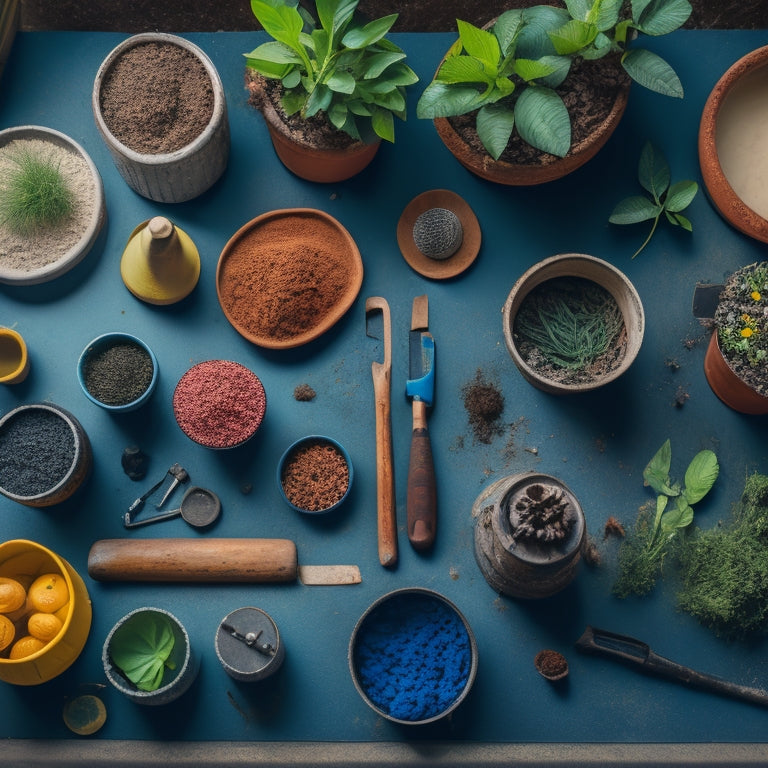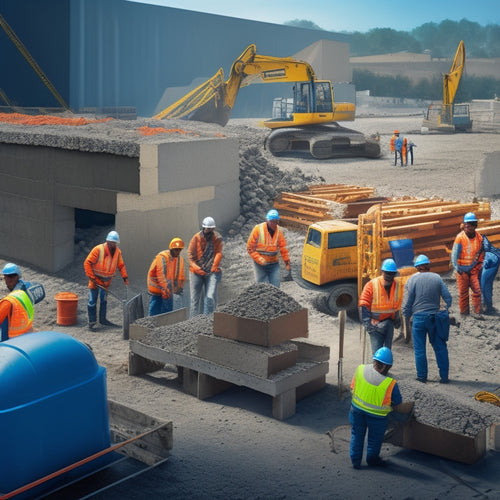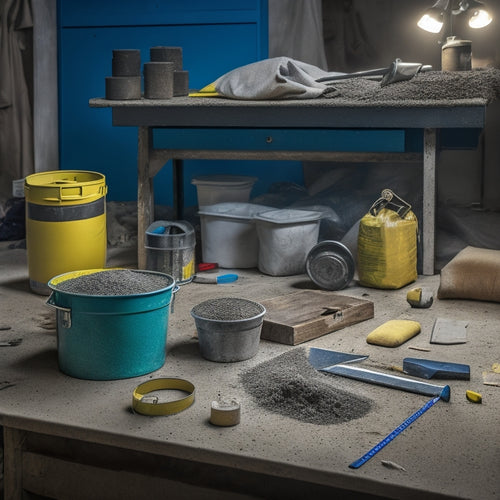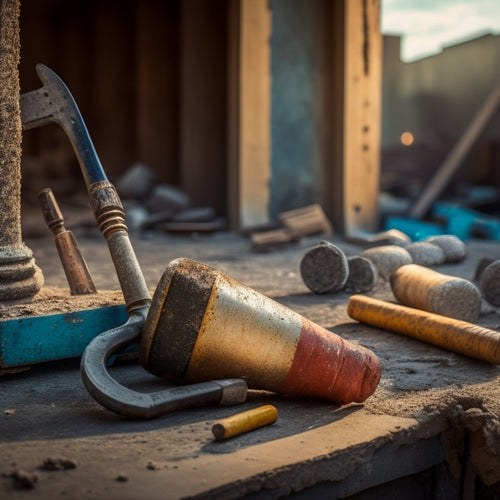
Why Choose These Essential Tools for Concrete Planters
Share
By investing in these essential tools, you'll take your concrete planters to the next level, ensuring quality, durability, and precision. From safety equipment like waterproof gloves and goggles to measuring tools like high-quality tape measures and levels, each tool serves a critical purpose. Heavy-duty mixing equipment, tamping and compacting tools, and cutting and shaping tools help you achieve perfect consistency and design. Finishing and smoothing tools, reinforcement and anchoring tools, and cleaning and maintenance tools complete the process. With these tools, you'll reveal the secrets to creating stunning, long-lasting planters that showcase your skills - and there's more to discover as you explore the world of concrete planter craftsmanship.
Key Takeaways
• These essential tools ensure precision, accuracy, and quality in concrete planter creation, resulting in professional-looking planters.
• They provide protection and safety for the user, preventing injuries and ensuring a clean working environment.
• The tools enable efficient and effective concrete mixing, tamping, cutting, shaping, and finishing, saving time and effort.
• They allow for customization and creativity in planter design, enabling unique and intricate patterns and shapes.
• The use of these essential tools increases the durability and longevity of concrete planters, making them more resistant to environmental conditions.
Safety Equipment for Protection
When working with concrete, you'll need to gear up with essential safety equipment to protect yourself from the harsh materials and physical demands of the process. Concrete can be unforgiving, so it's vital to prioritize your safety above all else.
Start by investing in a pair of sturdy, waterproof gloves that can withstand the abrasive nature of concrete. These won't only protect your hands from cuts and scrapes but also provide a secure grip on your tools.
Next, don't forget to wear a pair of safety goggles to shield your eyes from flying debris and dust. A face mask or respirator will also help prevent inhalation of harmful particles.
Make sure to wear a long-sleeved shirt, pants, and closed-toe shoes to cover your skin from any potential splashes or spills. Finally, consider wearing a hard hat to protect your head from falling objects or equipment.
Measuring Tools for Accuracy
As you start creating your concrete planters, you'll quickly realize that precise calculations matter.
You'll need to guarantee accurate dimensions to achieve the desired shape and size, and to avoid costly mistakes.
To get it right, you'll rely on measuring tools that provide exact readings, helping you craft planters that are both functional and visually appealing.
Precise Calculations Matter
You'll need to measure your concrete planter's dimensions accurately to assure a precise fit, which is where measuring tools come into play. With the right tools, you can guarantee that your planter turns out exactly as envisioned.
To achieve this level of precision, you'll want to employ advanced calculation techniques that account for every detail, from the planter's width and length to its depth and curvature. Precision practices, such as double-checking your measurements, will also help you avoid costly mistakes.
Invest in a high-quality tape measure, level, and calculator to streamline your measurement process. These tools will enable you to take accurate readings, perform complex calculations, and make adjustments on the fly.
By combining these tools with your own attention to detail, you'll be able to create planters that are both visually stunning and precisely crafted. Remember, precise calculations matter when it comes to concrete planters – so don't skimp on the tools that will help you achieve perfection.
With the right measuring tools, you'll be well on your way to creating planters that are truly exceptional.
Accurate Dimensions Ensure
Accurate dimensions are essential to creating a concrete planter that fits together seamlessly, and the right measuring tools guarantee you get them spot on. You want to confirm that your planter's design aesthetics aren't compromised by sloppy measurements. With precision planning, you can achieve a flawless finish that showcases your creativity.
Here are some must-have measuring tools to get accurate dimensions:
| Measuring Tool | Purpose |
|---|---|
| Tape measure | Measure length, width, and height of planter |
| Square | Ensure corners are precise and angles are accurate |
| Level | Guarantee planter is level and plumb |
| Calipers | Measure small details like hole diameters and thickness |
| Straightedge | Draw straight lines and edges |
Heavy-Duty Mixing Equipment
Heavy-Duty Mixing Equipment
Mixing concrete for planters demands a heavy-duty mixer that can handle thick, heavy mixtures and withstand the rigors of repeated use. You need a mixer that can tackle high-viscosity mixes with ease, guaranteeing your planters turn out strong and durable.
When choosing a mixer, consider its capacity, motor power, and drum material. A sturdy, rust-resistant drum is vital for withstanding the abrasive nature of concrete.
To get the most out of your mixer, it's essential to master various mixing techniques. Experiment with different mixing patterns and speeds to achieve the perfect consistency.
Additionally, prioritize equipment maintenance to extend the lifespan of your mixer. Regularly clean the drum and blades, and perform routine checks on the motor and gearbox. By doing so, you'll minimize downtime and guarantee consistent results.
With the right mixer and techniques, you'll be able to produce high-quality concrete planters that will impress.
Tamping and Compacting Tools
After pouring the mixed concrete into the planter mold, use tamping and compacting tools to eliminate air pockets and guarantee a dense, uniform finish. This step is essential, as air pockets can weaken the structure and lead to cracking. You'll need tools that allow you to apply consistent pressure and vibrations to compact the concrete. A handheld tamper or a plate compactor are excellent options for this task.
As you work, focus on using effective tamping techniques, such as gentle tapping motions or slow, deliberate presses. This will help distribute the force evenly and prevent creating new air pockets.
For larger planters, consider using compacting methods like vibrating tables or plate compactors, which can speed up the process and guarantee a solid finish. Remember to work in small sections, compacting the concrete in layers to achieve the best density.
Cutting and Shaping Tools
As you start creating your concrete planters, you'll need to shape and refine their edges and curves.
To do this, you'll rely on cutting and shaping tools that can handle the tough, dense material.
Now, let's take a closer look at the essential tools you'll need, including diamond blade saws, rotary hammer drills, and edging trowels.
Diamond Blade Saws
With a diamond blade saw in your arsenal, you can precision-cut and shape concrete planters to achieve the intricate designs and unique forms that set your creations apart. This powerful tool allows for precise control, making it ideal for crafting complex shapes and patterns.
When selecting a diamond blade, consider the type that best suits your project. There are various diamond blade types, including continuous rim, segmented, and turbo blades, each designed for specific cutting tasks. For instance, continuous rim blades are perfect for smooth cuts, while segmented blades are better suited for aggressive cutting.
To guarantee peak performance, regular blade maintenance is essential. Clean your blade frequently to prevent concrete buildup, and inspect it for damage or wear. Proper storage and handling will also extend the life of your blade.
Rotary Hammer Drills
You'll release a new level of precision and control when you add a rotary hammer drill to your concrete planter toolkit, allowing you to efficiently cut and shape concrete with ease. This powerful tool is designed to tackle tough concrete tasks, making it an essential addition to your arsenal. With a rotary hammer drill, you'll be able to create precise holes, cut through thick concrete, and shape your planters with accuracy.
Mastering drill techniques is key to revealing the full potential of your rotary hammer drill. By adjusting the drill speed and applying the right amount of pressure, you'll be able to tackle even the most challenging concrete projects.
The rotary hammer's ability to deliver high-torque power and rapid hammering action makes quick work of concrete, allowing you to focus on the finer details of your design. With a rotary hammer drill in your toolkit, you'll be able to take your concrete planter creations to the next level, achieving professional-looking results with ease.
Edging Trowels
Now that you've mastered the art of cutting and shaping concrete with your rotary hammer drill, it's time to refine those edges and details with an edging trowel, a precision cutting and shaping tool that lets you sculpt and smooth out your planters' curves and contours. This tool is essential for achieving a professional finish, as it allows you to add subtle nuances to your design.
When it comes to edging techniques, an edging trowel is a game-changer. Here are some benefits you can expect:
-
Precise control: Edging trowels give you the precision you need to create intricate designs and patterns.
-
Smooth finishes: They help you achieve a smooth, even finish that's free of imperfections.
-
Versatility: Edging trowels come in various materials, such as stainless steel, carbon steel, and fiberglass, each with its own unique benefits.
- Easy to use: With a little practice, you'll be able to master the art of edging and shaping concrete like a pro.
Sand and Cement Mixers
Mixing sand and cement efficiently requires a reliable tool, and that's where a sturdy sand and cement mixer comes in, allowing you to combine these essential components with ease.
With a mixer, you can master various mixing techniques, from gentle blending to vigorous stirring, to achieve the perfect consistency for your concrete planters.
To get the most out of your mixer, it's vital to maintain it properly. Regularly clean the mixer after each use, and perform routine checks on the blades and other moving parts to guarantee they're in good condition.
This will prevent clogs, rust, and other issues that can hinder performance.
Watering and Seeding Tools
As you move on to the next stage of crafting your concrete planters, precise water control and efficient seeding become essential, making high-quality watering and seeding tools indispensable.
You need to guarantee that your planters receive the right amount of water to prevent overwatering or underwatering, which can affect their structural integrity. In addition, selecting the right seeds for your planters is vital for their growth and development.
To achieve ideal results, consider investing in the following tools:
-
Watering cans with fine nozzles for precise water control
-
Moisture meters to monitor soil moisture levels
-
Seed trays with individual cells for organized seed selection
- Water spray bottles for gentle watering techniques
With these tools, you'll be able to master various watering techniques and seed selection methods to create thriving planters that showcase your creativity.
Finishing and Smoothing Tools
As you work on your concrete planter, you'll want to focus on the finer details to achieve a professional-looking finish.
You'll need to tackle edging and cornering, ensuring crisp lines and smooth shifts.
Next, you'll turn your attention to surface smoothening techniques and removing air pockets to create a flawless, bubble-free surface.
Edging and Cornering
You'll need specialized tools to create crisp edges and smooth corners, ensuring your concrete planters have a professional, polished look. These details can make or break the overall planter aesthetics. With the right tools, you can achieve creative designs that set your planters apart.
Here are some essential edging and cornering tools to add to your arsenal:
-
Edge trowels: Perfect for creating sharp, defined edges and removing excess concrete.
-
Corner trowels: Designed for reaching into tight spaces and smoothing out corners.
-
Edge shapers: Used to refine and shape edges for a more polished look.
- Radius trowels: Ideal for creating smooth, curved edges and corners.
Surface Smoothening Techniques
To achieve a smooth, even surface, start by employing a range of specialized tools that help eliminate air pockets, remove excess concrete, and refine the planter's texture. You'll need a combination of finishing and smoothing tools to get the desired surface finish.
For a high-gloss finish, use polishing techniques with progressively finer grits of sandpaper, working your way up to a mirror-like sheen. Alternatively, you can use a concrete sealer or wax to protect the surface and add a subtle shine. If you prefer a more textured look, use a trowel or float to create subtle ridges or patterns.
In addition to these manual techniques, consider investing in power tools like a grinder or polisher to speed up the process and achieve a more uniform surface finish.
Removing Air Pockets
Concrete planters often develop air pockets during the pouring process, and it's your job to eliminate these imperfections using specialized finishing and smoothing tools. Air pockets can compromise the structural integrity and aesthetic appeal of your planters, making air pocket removal a vital step in the process.
To achieve ideal concrete density, you'll need to get rid of those pesky air bubbles. Here are some must-have tools for the job:
-
Tamping tools: These help to remove air pockets and guarantee even concrete distribution.
-
Vibrating tables: They vibrate the mold to eliminate air bubbles and achieve a smooth finish.
-
Air hammers: These tools are perfect for removing stubborn air pockets and getting into tight spaces.
- Trowels: A trusty trowel helps to smooth out the surface and remove any remaining air bubbles.
Reinforcement and Anchoring Tools
Six essential reinforcement and anchoring tools will help you create sturdy, long-lasting planters that can withstand various environmental conditions. You'll be able to implement effective reinforcement techniques, such as adding fiber mesh or rebar, to strengthen your planters. With these tools, you'll guarantee your planters can resist cracking and breaking.
You'll also master anchoring methods, like using anchor bolts or screw anchors, to secure your planters to the ground or a wall. This will prevent them from toppling over or shifting in strong winds or earthquakes. Imagine having planters that remain stable and secure, even in harsh weather conditions.
The right reinforcement and anchoring tools will give you the control you need to create planters that are both beautiful and durable. You'll be able to experiment with different designs and shapes, knowing that your planters will be able to withstand the elements. With these tools, you'll take your planter-making skills to the next level and create stunning, long-lasting pieces that will impress anyone.
Cleaning and Maintenance Tools
You'll need a set of reliable cleaning and maintenance tools to keep your planters looking their best and prolong their lifespan. A well-maintained planter not only enhances the aesthetic appeal of your outdoor space but also prevents damage and guarantees the health of your plants.
To keep your planters in top condition, you'll need the following essentials:
-
A soft-bristled brush for gentle scrubbing and removing dirt and debris
-
A mild detergent and water mixture for effective cleaning without damaging the concrete
-
A pressure washer for tough stains and grime buildup
- A waterproof sealant to protect your planters from the elements and extend their lifespan
Frequently Asked Questions
Can I Use Regular Gardening Gloves for Concrete Planter Projects?
You wonder if regular gardening gloves will cut it for concrete planter projects. Honestly, they're not the best choice.
Those gloves are designed for gentle gardening tasks, not handling rough, heavy concrete. You need gloves made from durable, puncture-resistant materials like synthetic fabrics or thick leather to guarantee gardening safety.
Regular gloves will leave your hands vulnerable to cuts, abrasions, and strain. Invest in gloves specifically designed for concrete work to maintain control and protect your hands.
How Often Should I Oil My Heavy-Duty Mixing Equipment?
'A stitch in time saves nine' - and when it comes to your heavy-duty mixing equipment, regular oiling is key.
You should oil your gear after every 5-10 uses to prevent rust and corrosion. This heavy-duty maintenance guarantees your equipment runs smoothly, and your mixing techniques aren't compromised.
A well-oiled machine means less wear and tear, saving you time and money in the long run.
Are There Any Eco-Friendly Alternatives to Traditional Cement Mix?
You're looking for eco-friendly alternatives to traditional cement mix. Luckily, you've got some sustainable materials to choose from!
Consider using biodegradable options like hempcrete, a hemp-lime mixture that's durable and compostable.
Another option is earthbags, which are made from natural soil and can be reused or recycled.
These alternatives will give you the control you need to create a more environmentally friendly concrete planter.
Can I Reuse Concrete Planter Molds Without Cleaning Them First?
Did you know that the global concrete market is expected to reach $642 billion by 2027?
Now, about reusing those concrete planter molds: you shouldn't skip cleaning them first. Proper mold maintenance is essential for mold longevity.
If you don't clean them, debris and old concrete can affect the quality of your next project.
Take the time to scrub and dry your molds to guarantee a smooth, even finish on your next planter. Your plants (and your reputation) will thank you!
Do I Need to Seal My Concrete Planters to Protect Them From Weather?
You're wondering if sealing your concrete planters is necessary to protect them from harsh weather conditions. The answer is yes!
Unsealed concrete can absorb water, leading to cracks and damage. To guarantee your planters withstand the elements, you'll want to apply a sealant using various techniques, such as spraying, brushing, or rolling.
This will provide a protective barrier against weathering, ensuring your planters remain durable and long-lasting.
Conclusion
You've got the whole toolbox at your fingertips!
With these essential tools for concrete planters, you're all set to create stunning pieces that'll make your garden or indoor space shine.
Don't be a one-trick pony - mix and match these tools to bring your unique vision to life.
Remember, practice makes perfect, so get cracking and watch your skills bloom like a well-watered garden!
Related Posts
-

7 Best Tools for Concrete Block Construction
You'll need a solid foundation, precise cutting, and seamless finishing to guarantee your concrete block construction...
-

Top Mixing Tools for DIY Concrete Block Laying
When it comes to DIY concrete block laying, the right mixing tools are vital for a strong and durable structure. You'...
-

5 Tips for Splitting Concrete With Second-Hand Tools
When splitting concrete with second-hand tools, you'll need to be strategic to avoid wasting time, money, and putting...


